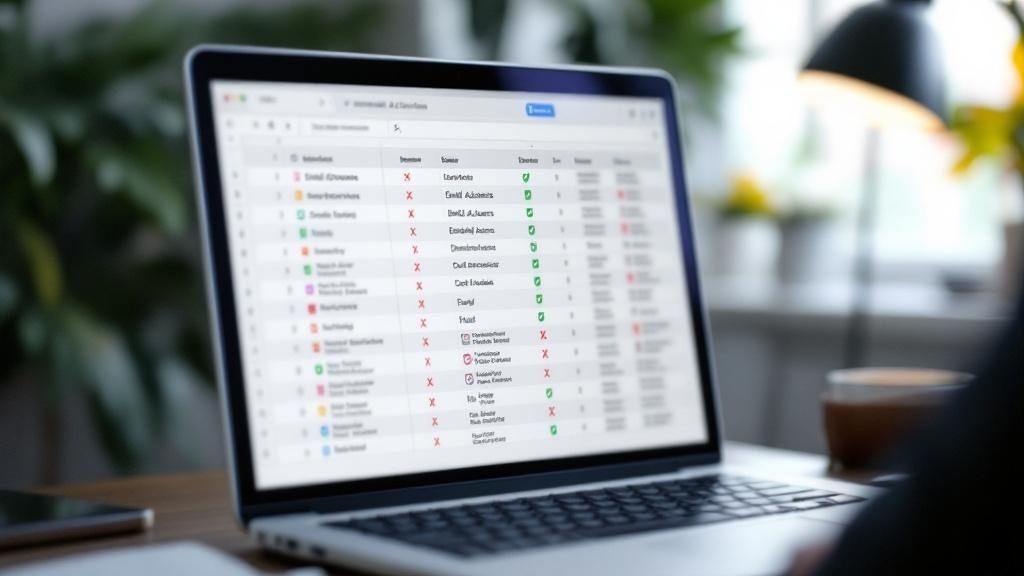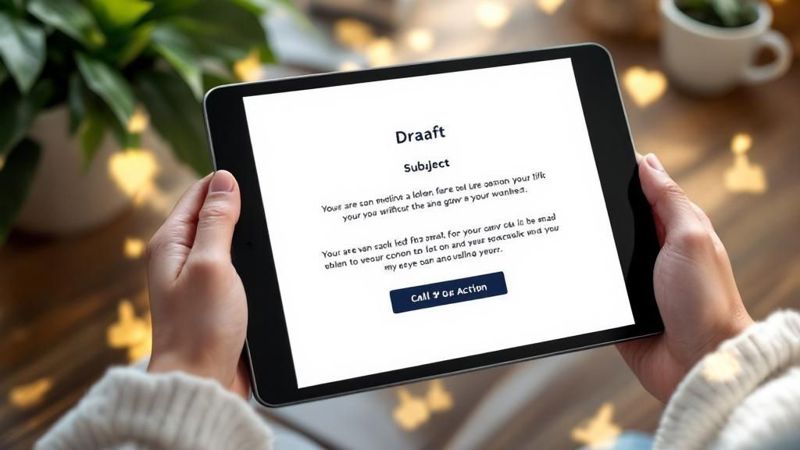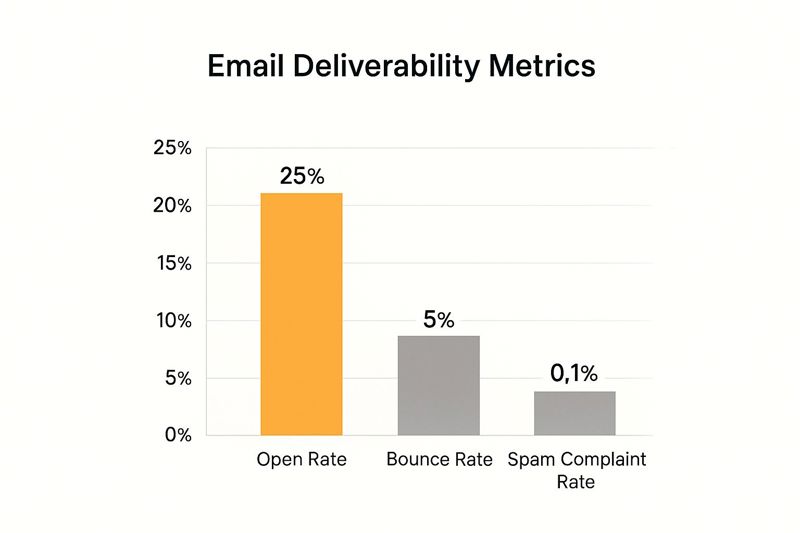Understanding What Really Drives Email Deliverability

Let's be honest: it's incredibly frustrating to see your carefully crafted emails vanish into the digital void. Instead of playing a guessing game, it's time to grasp the mechanics of email deliverability. This means looking beyond simple metrics like open rates and delving into the real factors that determine whether your message reaches the inbox.
The Signals ISPs Really Pay Attention To
Internet Service Providers (ISPs) act like gatekeepers, using complex algorithms to filter incoming emails. Their priority? The user experience. They work hard to weed out unwanted messages. Understanding their criteria is crucial for improving your email deliverability. And these criteria go far beyond simply avoiding spam trigger words.
ISPs place a heavy emphasis on engagement metrics. A high number of spam complaints is a serious red flag. Consistently low open and click-through rates also suggest your content isn't hitting the mark, impacting your sender reputation.
The Role of Sender Behavior and Content Quality
Think of your sender reputation as a credit score in the email world. Positive signals, like high engagement and few spam complaints, build a strong reputation, boosting your chances of landing in the inbox. Conversely, negative signals can damage your reputation and hinder your reach.
The quality of your content is equally vital. Emails filled with typos, broken links, or misleading information are more likely to be flagged as spam. Meticulous attention to detail and valuable content are key. Want to learn more? Check out this helpful guide: How to master email deliverability best practices.
Authentication and Reputation Scoring: Your Email's Passport
Email authentication protocols, such as SPF, DKIM, and DMARC, verify your identity as a sender. They're like a passport for your emails, assuring ISPs of your message's legitimacy. Robust authentication not only improves deliverability but also protects your brand from spoofing.
Reputation scoring adds another layer. ISPs track factors like bounce rates, spam complaints, and list hygiene to assign you a reputation score. A good score is essential for consistently reaching the inbox. With evolving privacy laws and AI-driven changes, email deliverability is becoming more challenging. In 2024, global inbox placement rates decreased, emphasizing the need for adaptive strategies. This report offers more detailed statistics.
Building a Holistic Strategy for Deliverability Success
Improving email deliverability demands a holistic strategy. It's about understanding the connections between sender behavior, content quality, recipient engagement, and technical setup. By focusing on these key elements, you influence how ISPs handle your messages, ensuring they arrive where intended.
This means consistently monitoring your sender reputation, cleaning your email list, and crafting engaging content are vital for better deliverability.
Building Your Sender Reputation From The Ground Up

Your sender reputation is a lot like a credit score for your email program. A single misstep can have a negative impact on how Internet Service Providers (ISPs) view you, similar to how a missed payment affects your financial credit. This can severely impact your email deliverability, making it harder to reach your audience. Let's dive into understanding the elements that shape your sender reputation and how to build a strong one.
Hidden Factors ISPs Track
ISPs are always watching, constantly evaluating various aspects of your sending practices. These range from easily measurable metrics like bounce rates to more complex elements like engagement velocity. A sudden surge in sending volume after a quiet period, for example, might raise a red flag, even if your emails contain legitimate content.
ISPs also pay close attention to spam complaints. A high number of complaints signals that your messages are unwanted or irrelevant, harming your reputation. This underscores the importance of targeted emails sent to engaged subscribers who want to hear from you.
Why Some Senders Recover and Others Don't
Recovering from a damaged reputation isn't impossible, but the journey back to good standing varies. Some senders recover quickly after implementing corrective actions, while others struggle. The primary difference usually lies in the severity and length of the negative behavior.
A short-term spike in bounce rates due to a temporary technical issue is often easier to fix than an extended period of high spam complaints. This highlights the importance of regular monitoring and addressing any problems immediately. Your email content plays a crucial role, too, as you want to avoid triggering spam filters. Consider these helpful Cold Email Templates for guidance.
Monitoring and Early Warning Signs
Proactive monitoring is essential for a healthy sender reputation. Using reputation monitoring tools allows you to keep an eye on your standing with major ISPs and identify potential problems before they become major issues. This includes regularly reviewing your sender score and using feedback loops to track spam complaints.
Monitoring alone isn’t sufficient, though. Recognizing early warning signs is equally critical. A gradual rise in spam complaints or a dip in open rates can point to underlying problems needing your attention. Addressing these early warnings helps prevent significant damage to your deliverability.
Building Long-Term Trust with ISPs
Consistently sending valuable, relevant content to engaged subscribers is the key to building long-term trust with ISPs. Segmenting your email list and tailoring messages to specific groups significantly improves engagement and reduces the likelihood of spam complaints.
Maintaining a clean email list is also paramount. Regularly removing inactive or invalid addresses shows ISPs that you respect their users' experience. This demonstrates your commitment to sending wanted emails.
Let’s summarize some of the key sender reputation factors and their impact:
To help visualize this, let’s take a look at the following table:
Sender Reputation Factors By Priority
| Reputation Factor | Impact Level | Time To Improve | Monitoring Method |
|---|---|---|---|
| Spam Complaints | High | Weeks to Months | Feedback Loops |
| Bounce Rates | High | Days to Weeks | Email Platform Analytics |
| Engagement Velocity | Medium | Days to Weeks | Email Platform Analytics |
| Sending Volume Consistency | Medium | Weeks | Email Platform Analytics |
| Email List Hygiene | Medium | Ongoing | List Cleaning Services |
This table highlights the crucial factors ISPs consider, their potential impact, and typical recovery times. It also lists the primary methods for monitoring each factor, allowing you to stay proactive.
By focusing on these factors, you can build a solid sender reputation and improve your email deliverability over the long term.
Mastering Authentication Without The Technical Headaches

Email authentication protocols are crucial for ensuring your messages land in the inbox. They're not just technicalities; they're your email's passport to credibility. Just as a passport verifies your identity to border control, email authentication verifies your identity to Internet Service Providers (ISPs), proving you are who you claim to be. An incomplete setup can seriously impact your email deliverability, hindering your messages from reaching their destination.
Understanding SPF, DKIM, and DMARC
Three main protocols work together to establish your email's legitimacy: SPF (Sender Policy Framework), DKIM (DomainKeys Identified Mail), and DMARC (Domain-based Message Authentication, Reporting & Conformance). Let's break down how they work together.
SPF specifies which mail servers are allowed to send emails on behalf of your domain. Think of it as a public list of approved senders, allowing ISPs to identify and block unauthorized emails.
DKIM adds a digital signature to every email, verifying the content hasn't been altered during transit. This signature acts like a tamper-proof seal, assuring recipients of the message's authenticity.
DMARC connects SPF and DKIM, giving you control over how ISPs handle emails that fail authentication. This adds a final layer of defense against spoofing and phishing.
Common Authentication Mistakes to Avoid
Even seasoned email marketers can make mistakes when setting up authentication. Here are some common pitfalls:
Incomplete SPF Records: An incomplete SPF record can accidentally block legitimate emails. Ensure all authorized sending sources are included.
Incorrect DKIM Setup: A misconfigured DKIM setup can invalidate your email signatures, making your messages look suspicious. Always double-check your setup for accuracy.
Missing or Weak DMARC Policy: Without a DMARC policy, you have no control over how ISPs handle emails that fail authentication. Implement a clear DMARC policy to protect your brand and boost deliverability.
The Benefits of Proper Authentication
Correctly configured authentication protocols improve your inbox placement and protect your brand from harmful spoofing attacks. These attacks can severely damage your sender reputation overnight, making strong authentication essential. Factors like DMARC adoption, regular list cleaning, and ethical list-building are key for maintaining high deliverability rates. Increased DMARC adoption helps reduce spam by ensuring proper email authentication, which in turn boosts sender reputation and improves inbox placement. Explore this topic further.
By understanding these seemingly intricate protocols, you'll not only improve your email deliverability but also protect your brand's reputation. This frees you to focus on what truly matters: connecting with your audience through compelling, effective emails. This proactive approach lays the foundation for ongoing success in your email marketing efforts.
Strategic List Management That Actually Works
Your email list is crucial for successful email marketing. However, a list full of inactive or invalid addresses can seriously hurt your email deliverability. Internet Service Providers (ISPs) monitor engagement. High bounce rates or low open rates signal that your emails are unwanted, landing you in the spam folder.
Identifying Problematic Addresses
A healthy email list needs regular cleaning. This means removing problematic addresses, and not just obvious hard bounces – emails that are permanently undeliverable. You should also look at:
- Soft bounces: Emails temporarily undeliverable, maybe because of a full inbox. Consistent soft bounces need attention.
- Spam traps: Email addresses designed to catch spammers. Hitting one severely damages your sender reputation.
- Inactive subscribers: Subscribers who haven't engaged with your emails for a while. They lower your engagement rates.
Re-Engagement Strategies That Work
Try to re-engage inactive subscribers before removing them. Here are some ideas:
- Personalized emails: Remind them why they subscribed and what they've missed.
- Special offers or incentives: Offer exclusive discounts or early access to reignite interest.
- Preference updates: Let subscribers choose content and frequency. Check out this guide on email segmentation best practices.
If re-engagement fails, remove those subscribers. A smaller, engaged list is better than a large, inactive one. Engaged subscribers are more likely to open, click, and convert, improving your email marketing performance.
The Psychology Behind Subscriber Behavior
Understanding subscriber behavior helps maintain engagement. People subscribe expecting valuable content. However, their interests change.
Segmenting your list by engagement, demographics, or purchase history keeps emails targeted. This prevents subscriber fatigue and encourages positive engagement.
Maintaining High Engagement Rates
High engagement (opens, clicks, replies) tells ISPs your emails are valuable. This improves email deliverability.
Here's what contributes to high engagement:
- Compelling subject lines: Strong subject lines encourage opens.
- Valuable content: Content must deliver on the subject line's promise.
- Clear call-to-actions: Make it easy for subscribers to take action. You can even use SMS verification without a phone.
Monitor and improve constantly. Track key metrics like open rates, click-through rates, and bounce rates. Email volume is immense. In 2022, around 333 billion emails were sent and received daily, projected to reach 392.5 billion in the future. See detailed statistics here. Refining your strategy keeps your audience engaged and your list healthy, improving your overall email deliverability.
Navigating Global Deliverability Like A Pro

The infographic above illustrates three essential email deliverability metrics: Open Rate (25%), Bounce Rate (5%), and Spam Complaint Rate (0.1%). Keeping your bounce and spam complaint rates low is critical. A higher open rate demonstrates positive engagement with your audience. Understanding the interplay of these metrics is key to improving your overall deliverability.
Reaching your audience effectively in the global email landscape requires understanding regional differences. What succeeds in one market may not in another. For instance, a well-performing North American campaign could be ineffective in Asia due to cultural differences and varying Internet Service Provider (ISP) preferences. This awareness is crucial for international expansion.
Regional Differences: A Closer Look
Regional differences have a significant impact on email deliverability and influence global marketing strategies. Canada, for example, enjoys a high inbox placement rate of about 90%, compared to the United States at roughly 85%. The Asia-Pacific region presents even more diverse results, with Australia near 90% while India lags at approximately 69-70%. Adapting your strategies to regional data is essential for maximizing your campaign's impact. Find more detailed statistics here.
The following table provides a deeper dive into global email deliverability rates by region, highlighting key challenges and recommended strategies.
Global Email Deliverability Rates By Region
| Region | Inbox Placement Rate | Key Challenges | Recommended Strategies |
|---|---|---|---|
| North America (US) | ~85% | Strict spam filters, high competition | List segmentation, consistent sending practices, engaging content |
| North America (Canada) | ~90% | CASL compliance, engagement maintenance | Preference centers, personalized content, regular list cleaning |
| Europe | ~80-90% (varies by country) | GDPR compliance, language barriers | Localized content, double opt-in, clear privacy policies |
| Asia-Pacific (Australia) | ~90% | Spam traps, engagement issues | Content localization, sending time optimization, sender reputation management |
| Asia-Pacific (India) | ~69-70% | Infrastructure limitations, spam filters | List hygiene, DMARC authentication, IP warm-up |
This table illustrates the importance of tailored strategies for each region. From strict spam filters in North America to infrastructure limitations in India, understanding these challenges is key to successful global email campaigns.
Adapting to Cultural Factors and ISP Policies
Cultural factors significantly influence how subscribers engage with your emails. Some cultures may be more open to promotional content than others. Researching and understanding your target audience's preferences in each region is essential.
ISP policies also vary globally. Stringent anti-spam laws in some countries affect email filtering and delivery. Adapting to these regulations is critical for maintaining a good sender reputation and ensuring inbox placement.
Segmenting Global Campaigns for Maximum Impact
Effective segmentation is crucial for improving global campaign deliverability. This involves tailoring your messaging and sending practices based on each target market's characteristics. Segmenting by region, language, and engagement level enables more effective personalization, improving open and click-through rates.
Tailoring Sending Practices to Maximize Inbox Placement
Customizing sending practices by region further enhances inbox placement rates. Optimize sending frequency and timing to align with local preferences. Using localized email templates and subject lines that resonate with the target audience can improve engagement and reduce spam complaints. This is particularly important for navigating international ISP requirements and varying consumer behaviors.
Maintaining Consistent Brand Messaging Across Diverse Markets
Balancing personalization with brand consistency is key when adapting to local preferences. While tone or calls to action might differ between regions, the core message and brand values should remain consistent. This builds a strong global brand image while ensuring your message resonates with local audiences. By implementing these strategies, you can successfully navigate the global email landscape and maximize your campaign performance in every market.
Key Takeaways For Deliverability Success
This guide offers practical advice and actionable steps to boost your email deliverability and achieve lasting success in email marketing.
Prioritize Your Sender Reputation
Your sender reputation is like a credit score for your email program. Internet Service Providers (ISPs) track metrics like bounce rates, spam complaints, and engagement to assess your reputation. A good reputation ensures your emails reach the inbox. This involves consistent monitoring, maintaining a clean list, and sending valuable content.
Monitor Regularly: Use tools like Sender Score to track your reputation with ISPs.
Maintain List Hygiene: Regularly remove inactive and invalid email addresses from your list.
Prioritize Engagement: Focus on delivering relevant content to engaged subscribers.
Authenticate Your Emails Like a Pro
Email authentication verifies your identity to ISPs. Implementing SPF, DKIM, and DMARC is essential. These protocols act like a passport for your emails, validating their legitimacy and protecting your brand from spoofing.
Implement SPF: The Sender Policy Framework (SPF) specifies which mail servers can send emails on behalf of your domain.
Configure DKIM: DomainKeys Identified Mail (DKIM) adds a digital signature to your emails, verifying their integrity.
Enforce DMARC: The Domain-based Message Authentication, Reporting & Conformance (DMARC) protocol tells ISPs how to handle emails that fail authentication checks.
Master the Art of List Management
A healthy email list is crucial for email marketing success. Strategic list management, including regular cleaning and targeted re-engagement campaigns, is key. Addressing potential issues proactively can prevent deliverability problems. For more tips on improving open rates, check out this helpful resource: How to master increasing email open rates.
Identify Problematic Addresses: Look for hard bounces, soft bounces, spam traps, and inactive subscribers.
Implement Re-Engagement Strategies: Reconnect with inactive subscribers through personalized emails and targeted offers.
Maintain a Clean List: Regularly remove unengaged subscribers to improve overall list health.
Navigate Global Deliverability Challenges
Email deliverability varies across regions. Understanding cultural nuances and adapting your strategies to regional ISP policies is essential for international success. This means tailoring your content and sending practices to resonate with different audiences while complying with local regulations.
Research Regional Differences: Be aware of inbox placement rates, challenges, and best practices in different markets.
Adapt to Cultural Factors: Consider cultural sensitivities and preferences when creating your messages.
Tailor Sending Practices: Adjust sending frequency and timing to local time zones and preferences.
Implement Continuous Improvement
Email deliverability is an ongoing process, not a one-time fix. Stay informed about industry best practices, track your performance, and adapt to changing ISP requirements. This proactive approach will help maintain consistent inbox placement and maximize the impact of your email marketing.
Want to elevate your email personalization? OKZest lets you create dynamic, personalized images to capture attention and boost engagement. Discover how OKZest can enhance your email marketing.